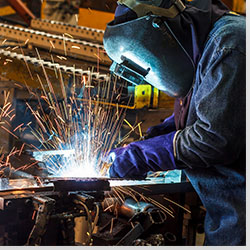In industries and workplaces where exposure to heat or fire is a risk, having the right heat resistant gloves is essential to make sure workers are safe. Without the proper PPE equipment, your workplace won’t only put employees at risk, it will also be uncompliant with European regulations.
A Guide To Heat Resistant Gloves

Types of Heat Resistant Gloves
There are many types of heat resistant gauntlets and gloves, with each one suited to specific industries or tasks. Here is a list of some of the most common and popular types of heat protective gloves:
Low heat resistant gloves
These offer resistance to lower levels of heat and generally offer abrasion or cut resistance as well. They’re most commonly used in workplaces where there is a low level of heat exposure risk.
Extreme heat resistant gloves
These protect workers from the highest levels of heat and will usually be certified up to a specific temperature. They can differ in design depending on whether the heat they protect against is dry or moist and flame or spark based.
Heat resistant gauntlets
Fire retardant gloves
Foundry heat beater gloves
These offer exceptional protection from heat and are specifically designed for heavy-duty tasks like melting or casting metals.
Who uses heat resistant gloves?
Regulations for heat resistant gloves
- - EN 407 – This European Standard concerns gloves which give protection from thermal hazards. This means that the likes of resistance to flammability, resistance to contact heat, resistance to convective heat, resistance to radiant heat and resistance to splashes of molten metal must all be displayed on a pictogram on the product’s packaging.
- - EN 12477 – This European Standard describes the level of protection that PPE gloves are meant to provide to the hand and wrist when used for welding or similar tasks. It takes into account testing from EN 407 and EN 388 (gloves that protect from mechanical risks).
- - EN 420 – This European Standard defines requirements for the construction of protective gloves, whether they are fit for purpose and their safety.
Employers’ Responsibilities
Comments
Latest Blogs

An updated guide by consumer organization Which? looks at how to protect people’s ears. They focus on two main types of ear protection, earplugs and ear defenders.

A review submitted by the Department of Work and Pensions (DWP) has recommended that the Health and Safety Executive (HSE) should compel employers to improve their behaviour in issues of workplace health and safety.

Drivers are being urged to consider their footwear choices when behind the wheel, particularly during hot summer days when flip-flops are popular.

Leave a comment